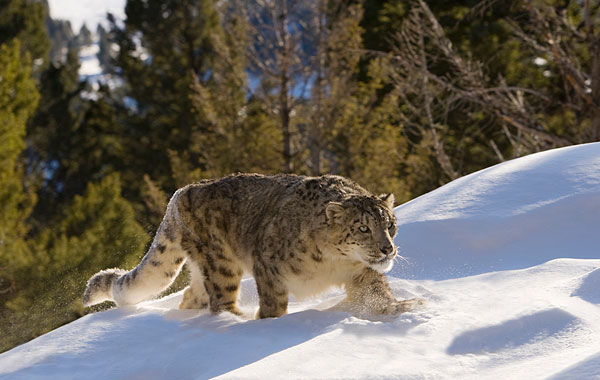Climate change threatens the habitat of snow leopard
Research by the International Fund for Nature Protection (WWF) said that if greenhouse gas emissions continue to increase today, populations of snow leopard (Panthera uncia) in the Himalayas could lose 30% of the environment. their life.
>>>First image of Snow Leopard in Russia
With an increasing number of people, it is estimated that there are only between 4,000 and 6,500 individuals, snow leopard is being classified as endangered (EN) in the IUCN Red List. This leopard species usually resides in high mountain areas below 5,000m to hunt for prey but does not live in forested areas. When the climate gets hot, the humidity pushes the plants to grow faster and will gradually narrow the habitat of the snow leopard.

Snow leopard
This ability has been verified by the WWF team through the use of computational modeling and field observation in the highlands of the Himalayas - where snow leopard lives.
The study also found that the loss of habitat in the high mountains is not merely narrowing the living space of snow leopard but also making it easier for people to fall into the sights of humans. Because, when it is not possible to feed on familiar habitats, snow leopard is forced to migrate to lower altitudes and shift the target of hunting to the herds. This quickly turns them into enemies of humans.
To avoid pushing snow leopard to the brink of extinction, the researchers believe that in addition to monitoring the impact of climate change and finding solutions to adaptation, effective management, the government and its people need efforts. Minimize the threat of leopards, including illegal hunting, conflicts between people and wildlife, or grazing in the living area of the snow leopard.
Through identifying climate-resilient and potentially tolerant areas of snow leopard populations, the team also stressed the need to strengthen cross-border collaborative efforts. Worlds to save rare leopard species from threats that are directly threatening their survival.
- The world's rarest cheetah is officially removed from the Red Book
- Struck with sheep and snow from a cliff 100 meters high
- Hope for snow leopard in Bhutan
- Early image of Snow Leopard in Russia
- Rare and precious snow leopard appears in China
- Top 8 animals are on the verge of extinction
- Climate change threatens human life
- Greenland Island will be completely transformed by 2100
- North American mink is at risk of extinction due to melting ice
- How do dogs turn into wolves?
- Climate change threatens many species in Europe
- Climate change is a global concern but for this animal is happiness
 Is the magnetic North Pole shift dangerous to humanity?
Is the magnetic North Pole shift dangerous to humanity? Washington legalizes the recycling of human bodies into fertilizer
Washington legalizes the recycling of human bodies into fertilizer Lightning stone - the mysterious guest
Lightning stone - the mysterious guest Stunned by the mysterious sunset, strange appearance
Stunned by the mysterious sunset, strange appearance The incredible 'resurrection' of an antelope after being captured by a leopard
The incredible 'resurrection' of an antelope after being captured by a leopard  An animal that has been extinct for 40 years suddenly 'reappears': Instead of being happy, scientists are scared!
An animal that has been extinct for 40 years suddenly 'reappears': Instead of being happy, scientists are scared!  Blind leopard fights with crocodiles over antelope carcass
Blind leopard fights with crocodiles over antelope carcass  Mother leopard risks her life to wrestle with lion to protect her cub
Mother leopard risks her life to wrestle with lion to protect her cub  Leopard failed to hide prey
Leopard failed to hide prey  The group of baboons watched helplessly as their fellow creatures fell under the clutches of the leopard
The group of baboons watched helplessly as their fellow creatures fell under the clutches of the leopard 